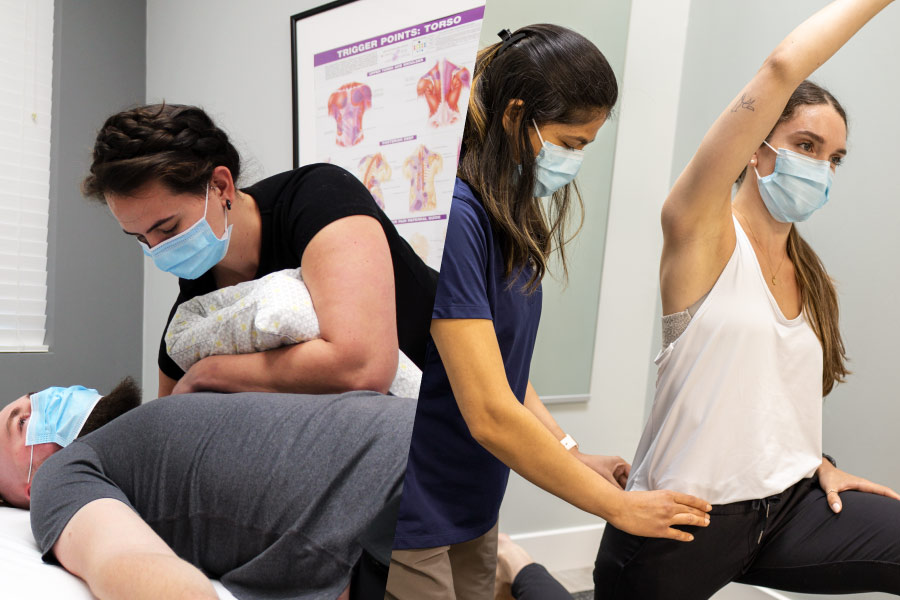
Physiotherapy vs. Osteopathy: Which is Right for You?
Both physiotherapy and osteopathy are ways to treat the body and work to heal injuries and reduce pain. However, despite some common misconceptions, they are not the same. Many people who come to our clinic question which one of these methods is right for them and the specific issues they face.
There are definitely some important things to consider when weighing physiotherapy versus osteopathy, such as the specific problem you want to treat or personal preferences toward addressing medical issues. Here we’ll give you an overview of both types of rehabilitative therapy and talk about some essential things you should know when deciding which of the options is the right one for you.
What is Physiotherapy?
Physiotherapy, also known as Physical Therapy, helps people with certain types of injuries or disabilities repair them and restore proper movement and function. The types of injuries that physiotherapists treat vary greatly and can include many issues related to joints, muscles, tendons, ligaments, and other areas.
Regarding the therapies physiotherapists use, you’ll find anything from manual techniques and exercises to intermuscular stimulation, shockwave therapy, and deep tissue lasers. The physiotherapist assesses your situation, works to understand your injury or limitation, and then develops the technique (or techniques) and exercises best suited to help you recover and regain full function. Often, the physiotherapist will instruct you on specific exercises to perform repeatedly at home daily as you work to repair the issue.
Generally, physiotherapy focuses on a specific part of the body that needs repairing, such as one that has suffered damage from a sports injury or a fall (i.e., a dislocated shoulder or knee injury). However, they can also work with issues relating to the brain, nerves, and cardiovascular and respiratory systems. Some may also specialize in treating the aches and pains that often occur during pregnancy.

When Should I Schedule an Appointment with a Physiotherapist?
Some examples of conditions that benefit from a visit to a physiotherapist include:
- Musculoskeletal Injuries (sprains, strains, fractures, tendonitis, TMJ, neck pain, and much more)
- Repetitive strains (carpal tunnel, rotator cuff, tennis/golf elbow)
- Degenerative conditions (arthritis/osteoarthritis, degenerative discs, etc.)
- Motor vehicle accident injuries (whiplash, concussion, sprains, vestibular issues)
- Sports-related injuries (both simple and traumatic)
- Pelvic health conditions (prolapse, incontinence pain, issues with pelvic muscles, pregnancy)
If the issue you’re experiencing falls into one of these categories, you should consider scheduling a physiotherapy appointment.
What is Osteopathy?
Where physiotherapy focuses on a specific area of the body and uses tangible exercises and other manipulation techniques to repair it, osteopathy looks more at the body as a whole. This “holistic” approach operates on the premise that all of the systems and parts of the body relate to each other, and to achieve and maintain good health, you must ensure that they remain in proper balance.
For example, if you come to an osteopathic practitioner with a shoulder issue, they will consider that other areas of your body (and even your internal organs) may be contributing to or triggering your pain and seek to get to the root cause. A physiotherapist will look specifically at the shoulder to address the issue.
Instead of prescribing specific exercises or movements for you to do to address the pain issue, an osteopathic practitioner will instead focus on hands-on therapy techniques to resolve the issue. This therapy is very gentle in nature, and everyone from small infants to the elderly can participate in it, as it usually involves lying down in a relaxed state. During this time, the osteopathic practitioner manipulates areas of the body through touch.
After realigning your body, the osteopathic practitioner will advise you on lifestyle changes or routines you can continue with after leaving to help avoid the issues in the future or prevent them from worsening. Therefore, in many instances, it is considered a “preventative” therapy, as it works to help you avoid potential problems further down the road.

When Should I Schedule an Appointment with an Osteopathic practitioner?
Consider scheduling an appointment with an Osteopathic practitioner if you suffer from certain chronic conditions, lingering aches and pains, or a general feeling that you’re imbalanced or something is “off” with your body. Many people have found that osteopathy relieves conditions that have plagued them for years but that they could never adequately describe as a specific problem.
Some specific conditions that osteopaths treat include:
- Back and neck pain
- Headaches and migraines
- Pelvic pain
- Shoulder, knee, or ankle issues
- Stress management
- Digestive complaints/disorders
Of course, this list is not exhaustive of the areas where a patient can benefit from osteopathy. If you have a bothersome condition not listed here that you would like an osteopathic practitioner to investigate, they’ll be happy to look at the situation and help determine the root cause.
What Are Some Other Differences Between the Two?
Other than the style and methods they use to treat pain and injuries, one of the main differences between a physiotherapist and an osteopathic practitioner is their education and specific qualifications.
A Physiotherapist must have a specialized degree in Physiotherapy to practice this form of therapy. In obtaining this degree, they receive a lot of training related to their work, including acquiring knowledge of various methods and specializations, such as Orthopedics. After completing their educational degree, a Physiotherapist next completes a special required exam. It is only after passing that exam that they will be considered a registered Physiotherapist.
Of course, an Osteopathic practitioner is also an expert in their field and has a good amount of education and qualifications. Osteopathic practitioners also take advanced education including clinical practice and obtain a degree or diploma in their field. Many osteopathy training programs also require a degree in related subjects such as massage therapy or athletic therapy as a prerequisite.
How to Decide Whether Physiotherapy or Osteopathy is Right for You
In addition to considering your specific injury or limitation, you should also consider the philosophy of how you want to approach your medical treatment.
Of course, if you’re dealing with an ankle fracture and want to recover your full functionality after it has healed, you’ll likely want to visit a physiotherapist. The physiotherapist will prescribe some exercises to help your range of motion, strengthen the ankle, and improve your balance and mobility. After repeating these exercises for a specified time, your injury should heal.
However, for other more “grey” areas, like general pelvic pain or lower back pain, you can choose based on your preference. A person who’s struggled with generalized lower back pain for a while may want to see an osteopathic practitioner to help determine the root cause of the issue. In contrast, someone with back pain due to arthritis may instead consider physiotherapy to learn exercises that relieve the pain.
Additionally, osteopathy appeals to individuals who prefer holistic medicine over traditional medicine, so it makes a good choice for individuals to whom that consideration is important.
Final Words
Hopefully, you now have a good understanding of the differences between physiotherapy and osteopathy and some key things you can think about when determining which one would work best for you. At Encompass Sports Therapy, we’re happy to discuss your specific condition or concerns. We can also recommend whether physiotherapy versus osteopathy would work best for you.
